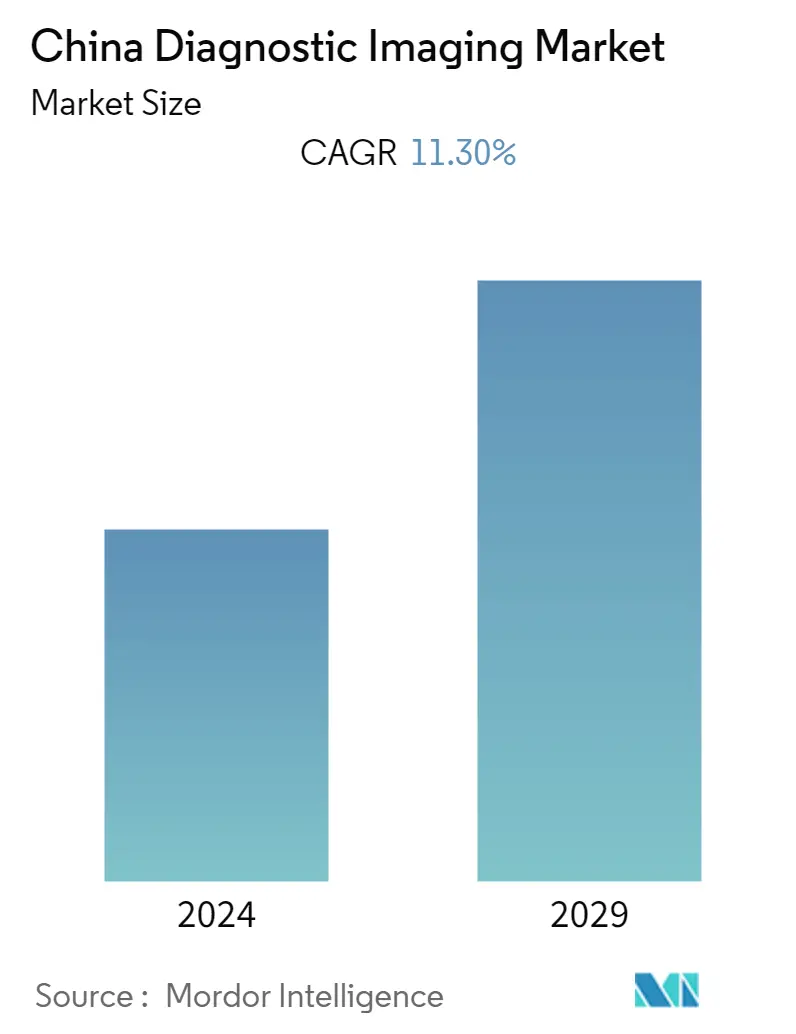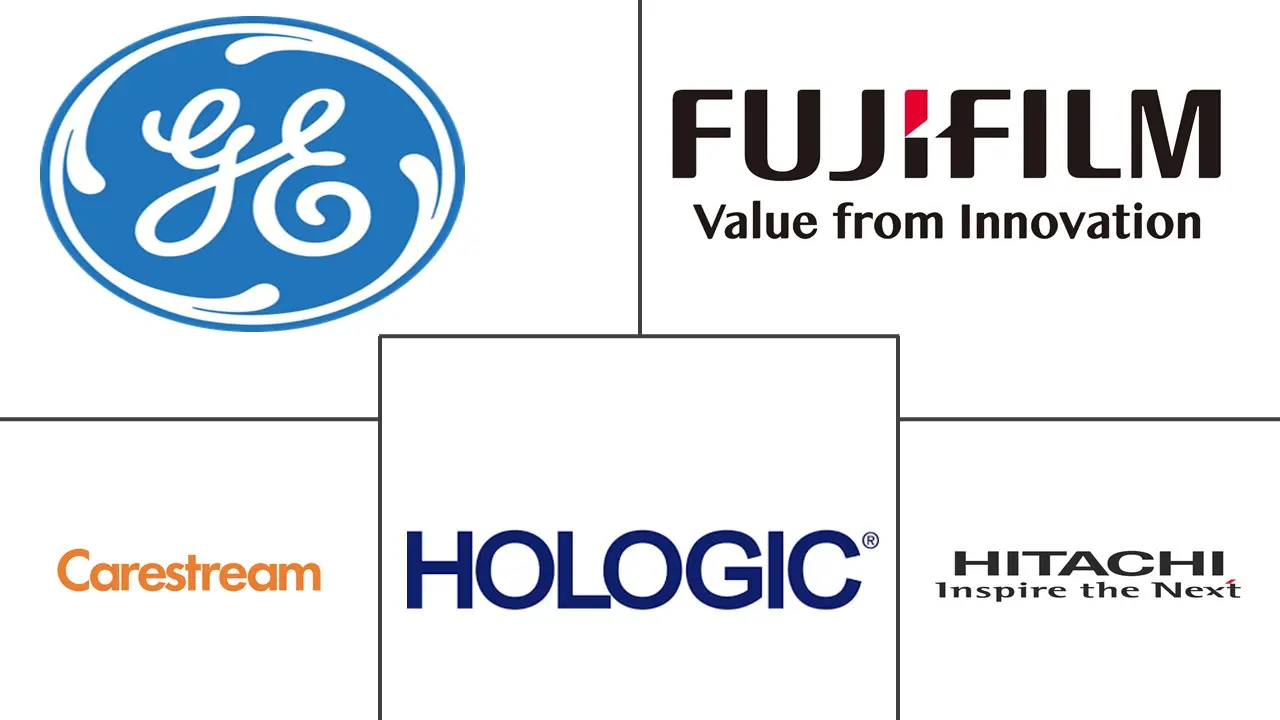Market Size of China Diagnostic Imaging Industry

| Study Period | 2019 - 2029 |
| Base Year For Estimation | 2023 |
| Forecast Data Period | 2024 - 2029 |
| Historical Data Period | 2019 - 2022 |
| CAGR | 11.30 % |
Major Players
*Disclaimer: Major Players sorted in no particular order |
China Diagnostic Imaging Market Analysis
The China diagnostic imaging market is expected to register a CAGR of 11.3% during the forecast period(2022 - 2027). The market is expected to show healthy growth owing to the growing prevalence of chronic diseases, the growing geriatric population, and the increased adoption of advanced technologies in medical imaging.
With the rising geriatric population, the country is found witnessing a significant increase in the number of patients suffering from chronic diseases.
According to an article titled 'China's Ageing Population: The Present Situation and Prospects' published in April 2020, both quantitatively and structurally, the population of China is aging quickly. About 6.2 million persons over the age of 60 are added to the population every year. According to this definition of the elderly, 280 million people will be considered elderly in China by 2025. As the aged population is more prone to chronic diseases such as cardiovascular, cancer, respiratory and neurological diseases which will boost the market during the forecast period.
Hence it is seen that most of the elderly population are utilizing diagnostic imaging techniques, as compared to the younger people. Therefore, the growing geriatric population is expected to augment the demand for the diagnostic imaging market.
There are also many advancements made in the field that are accelerating the speed to capture high-quality diagnostic images, capturing images at the right place and right time, to help provide better patient care at less cost, thus automating the workflow, and acting as one of the major drivers of the market.
China Diagnostic Imaging Industry Segmentation
As per the scope of the report, diagnostic imaging captures images of the internal structure of the human body using electromagnetic radiation for an accurate diagnosis. There are various types of medical imaging, the most common ones being CT scanners, MRI systems, etc. The China diagnostic imaging market is segmented by modality, application, end-user and geography. The report offers the value (in USD million) for the above segments.
| By Modality | |||||
| |||||
| |||||
| |||||
| |||||
| |||||
| Fluoroscopy | |||||
| Mammography |
| By Application | |
| Cardiology | |
| Oncology | |
| Neurology | |
| Orthopedics | |
| Gastroenterology | |
| Gynecology | |
| Other Applications |
| By End-User | |
| Hospitals | |
| Diagnostic Centers | |
| Other End-Users |
China Diagnostic Imaging Market Size Summary
The China diagnostic imaging market is poised for robust expansion, driven by the increasing prevalence of chronic diseases and a rapidly aging population. As the elderly demographic grows, so does the incidence of age-related health issues, necessitating advanced diagnostic imaging solutions. This trend is further supported by technological advancements that enhance the quality and efficiency of medical imaging, thereby improving patient care while reducing costs. The market's growth is also fueled by the rising cancer burden, which remains a leading cause of mortality in China. The demand for cost-effective and advanced imaging techniques is expected to rise as the country grapples with the challenges posed by an aging population and the need for effective cancer diagnosis and prevention.
The competitive landscape of the China diagnostic imaging market is moderately consolidated, with several key players holding significant market shares. Companies such as Canon Medical Systems Corporation, Carestream Health Inc., Fujifilm Holding, GE Healthcare, Hitachi Medical Systems, and Hologic Corporation are at the forefront, driving innovation and market dynamics. The fragmented nature of the market indicates a competitive environment where these major players are continually striving to enhance their offerings and capture a larger share of the market. As the demand for diagnostic imaging solutions continues to grow, these companies are well-positioned to leverage their technological advancements and market presence to meet the evolving healthcare needs of the Chinese population.
China Diagnostic Imaging Market Size - Table of Contents
-
1. MARKET DYNAMICS
-
1.1 Market Overview
-
1.2 Market Drivers
-
1.2.1 Rise in the Prevalence of Chronic Diseases
-
1.2.2 Growing Geriatric Population
-
1.2.3 Increased Adoption of Advanced Technologies in Medical Imaging
-
-
1.3 Market Restraints
-
1.3.1 High Costs Associated With the Devices
-
1.3.2 Side Effects of Diagnostic Imaging Procedures
-
-
1.4 Porter's Five Force Analysis
-
1.4.1 Threat of New Entrants
-
1.4.2 Bargaining Power of Buyers/Consumers
-
1.4.3 Bargaining Power of Suppliers
-
1.4.4 Threat of Substitute Products
-
1.4.5 Intensity of Competitive Rivalry
-
-
-
2. MARKET SEGMENTATION
-
2.1 By Modality
-
2.1.1 MRI
-
2.1.1.1 Low and mid field MRI systems (less than 1.5 T)
-
2.1.1.2 High field MRI systems (1.5-3 T)
-
2.1.1.3 Very High, and Ultra High Field MRI Systems (3T and more)
-
-
2.1.2 Computed Tomography
-
2.1.2.1 Low End Scanners (~16-Slice)
-
2.1.2.2 Mid Range Scanners (~64-Slice)
-
2.1.2.3 High End Scanners (128-Slice and More)
-
-
2.1.3 Ultrasound
-
2.1.3.1 2D Ultrasound
-
2.1.3.2 3D Ultrasound
-
2.1.3.3 Others
-
-
2.1.4 X-Ray
-
2.1.4.1 Analog Systems
-
2.1.4.2 Digital Systems
-
-
2.1.5 Nuclear Imaging
-
2.1.5.1 Positron Emission Tomography (PET)
-
2.1.5.2 Single Photon Emission Computed Tomography (SPECT)
-
-
2.1.6 Fluoroscopy
-
2.1.7 Mammography
-
-
2.2 By Application
-
2.2.1 Cardiology
-
2.2.2 Oncology
-
2.2.3 Neurology
-
2.2.4 Orthopedics
-
2.2.5 Gastroenterology
-
2.2.6 Gynecology
-
2.2.7 Other Applications
-
-
2.3 By End-User
-
2.3.1 Hospitals
-
2.3.2 Diagnostic Centers
-
2.3.3 Other End-Users
-
-
China Diagnostic Imaging Market Size FAQs
What is the current China Diagnostic Imaging Market size?
The China Diagnostic Imaging Market is projected to register a CAGR of 11.30% during the forecast period (2024-2029)
Who are the key players in China Diagnostic Imaging Market?
Carestream Health Inc., Fujifilm Holding, GE Healthcare (GE Company), Hitachi Medical Systems and Hologic Corporation are the major companies operating in the China Diagnostic Imaging Market.

